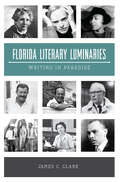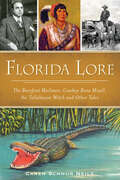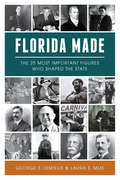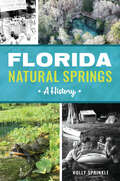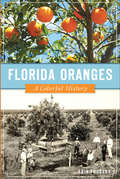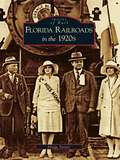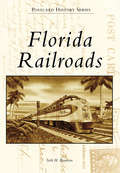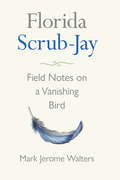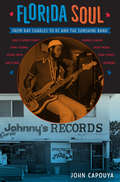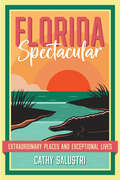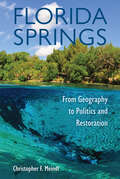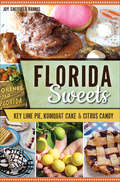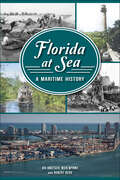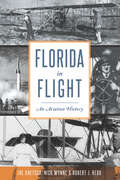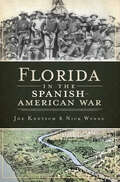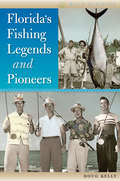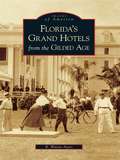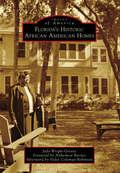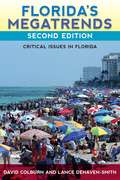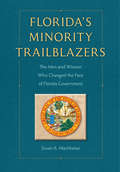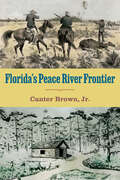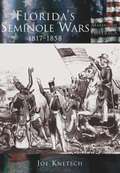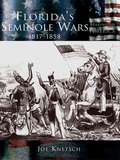- Table View
- List View
Florida Literary Luminaries: Writing in Paradise
by James C. ClarkSit down for a spell with the bevy of famed writers who've found inspiration in the Florida sun. From the Spanish explorer Cabeza de Vaca to James Patterson, writers have found inspiration in the Florida sunshine. Ernest Hemingway met his future wife at Sloppy Joe's in Key West. John Kennedy recovered from back surgery in Palm Beach while working on his Pulitzer Prize winning book. James Weldon Johnson wrote what became The Negro National Anthem at the Stanton School in Jacksonville. And Edna St. Vincent Millay watched in shock as her manuscript went up in flames in Sanibel. Florida historian James Clark tells the stories of scores of writers including Robert Frost, Jack Kerouac, John D. MacDonald, and Stephen King. Hunter Thompson driving through the streets of Key West using a bullhorn to warn the citizens, Tennessee Williams partying with Truman Capote, Ring Lardner planning a get together with Al Capone--it's all here.
Florida Lore: The Barefoot Mailman, Cowboy Bone Mizell, the Tallahassee Witch and Other Tales (American Legends Ser.)
by Caren Schnur NeileThis fascinating collection of myths, legends and folktales celebrates the diversity of characters and cultures across the Sunshine State. Florida boasts mysterious tales that stretch back more than twelve thousand years. In Florida Lore, storyteller Caren Schnur Neile shares a treasure trove of colorful, curious tales that capture her home state&’s history, mystery, and unique personality. Delve into the lives of the proud Wakulla Pocahontas and the Ghost of Bellamy Bridge. Meet local lawbreakers like John Ashley, as well as transplants like Ma Barker and Al Capone. Stalk stumpy gators or Hogzilla as they prowl Florida's swamps and suburbs. Discover the quintessential Cracker cowboy and the Barefoot Mailman, plus the origin of names like Boca Raton and Orlando.
Florida Made: The 25 Most Important Figures Who Shaped the State
by Laura E. Mize George S. LeMieuxFlorida is in many ways both the oldest and newest of the megastates. Once an insect-ridden swampland, it is now a top destination for tourism, business, agriculture and innovation. The ideas and actions of a colorful cast of characters--from beloved cultural icons to political heroes and even a socialist dictator--transformed the peninsula. A Barbados native rescued Florida's orange industry after the catastrophic 1835 freeze. Known as the "Grande Dame of the Everglades," Marjory Stoneman Douglas worked tirelessly to save the state's vast, incomparable wetlands from annihilation in the early twentieth century. In the mid-1800s, a Florida doctor developed a precursor to modern air conditioning. Join former U.S. senator George LeMieux and journalist Laura Mize as they profile and rank, according to impact, the twenty-five trailblazers who have changed the state forever.
Florida Natural Springs: A History
by Holly SprinkleAuthor Holly Sprinkle unveils the secrets hidden within Florida's aquatic wonders. Florida's springs swirl a spectrum of greens and blues with a crystal clarity seen nowhere else in the world. "Springhunting" is a cherished regional pastime, but these ancient oases have served as a beacon for humans and beasts alike since time immemorial. Giant sloths, mammoths and armadillos once centered their lives around these springs--the endangered West Indian Manatee still seeks refuge in the relatively warm springs during the winter months. These enchanting waters sustain ecosystems and inspire everything from feelings of deep serenity to legends involving curses, ghosts and alien visitation.
Florida Oranges: A Colorful History (American Palate)
by Erin ThursbyA vibrant history of Florida&’s horticultural heritage and the colorful personalities who made the state synonymous with citrus. In the 16th century, Ponce de León planted the first orange groves in St. Augustine, Florida. They were the precursor to what would become an integral part of Florida&’s identity. Orange groves slowly spread across the state, inspiring agricultural innovations and manufacturing ingenuity. Now Florida food writer Erin Thursby reveals the surprisingly colorful history of Florida&’s most famous crop. Discover the story behind Deland&’s eccentric &“citrus wizard&” Lue Gim Gong; the rise and fall of smuggler Jesse Fish; and the silver-tongued politician William J. Howey, who made his fortune selling plots of groveland through the 1920s. Celebrate the heyday of orange tourism and the farmers who weathered freezes, floods and citrus greening. From the old roots of orange cultivation in Northeast Florida to the new center of oranges in the Southwest, Thursby offers a unique historical tour of the Sunshine State.
Florida Railroads in the 1920's
by Gregg TurnerFlorida's railroads emerged in the 1830s amid Native American upheaval and territorial colonization. Many periods of development marked this fascinating heritage, but one era towers above the rest: the 1920s. It was then that Florida experienced a colossal land boom, one of the greatest migration and building stories in American history. People poured into the state as never before, real estate traded hands at breakneck speed, and the landscape added countless new homes, hotels, apartments, and commercial buildings. Florida's biggest railroads--the Atlantic Coast Line, Seaboard Air Line, and Florida East Coast--were unprepared for the tidal wave of traffic. Thus, the "Big Three" had to rapidly expand and increase capacity. Dozens of projects unfolded at great cost, by one estimate over $100 million. When the building frenzy ended, the railway map of the state stood at its greatest extent--some 5,700 miles. Further, the frequency of railway service within and to the Sunshine State reached an unprecedented level, never again to be repeated.
Florida Railroads: From Railroad Boom To Sonic Boom (Postcard History Series)
by Seth H. BramsonThe history of Florida railroads began as early as 1834, when the Tallahassee-St. Marks Railroad incorporated. On April 14, 1836, the St. Joseph-Lake Wimico line was the first to be put into service, with trains operating between the boomtown of St. Joseph and the Apalachicola River. Although the Florida railroad "boom" began with Henry Flagler and Henry Bradley Plant, the expansion continued into the 1920s when the president of Seaboard Railway, S. Davies Warfield, extended his lines to Miami and Naples. With the passage of time, numerous railroads were bought, merged, or abandoned. Today, 12 full-service railroads are still operating as well as several port railroads.
Florida Scrub-Jay: Field Notes on a Vanishing Bird
by Mark Jerome WaltersA portrait of a species on the brink The only bird species that lives exclusively in Florida, the Florida scrub-jay was once common across the peninsula. But as development over the last 100 years reduced the habitat on which the bird depends from 39 counties to three, the species became endangered. With a writer’s eye and an explorer’s spirit, Mark Walters travels the state to report on the natural history and current predicament of Florida’s flagship bird.Tracing the millions of years of evolution and migration that led to the development of songbirds and this unique species of jay, Walters describes the Florida bird’s long, graceful tail, its hues that blend from one to the next, and its notoriously friendly manner. He then focuses on the massive land-reclamation and canal-building projects of the twentieth century that ate away at the ancient oak scrub heartlands where the bird was abundant, reducing its population by 90 percent.Walters also investigates conservation efforts taking place today. On a series of field excursions, he introduces the people who are leading the charge to save the bird from extinction—those who gather for annual counts of the species in fragmented and overlooked areas of scrub; those who relocate populations of scrub-jays out of harm’s way; those who survey and purchase land to create wildlife refuges; and those who advocate for the prescribed fires that keep scrub ecosystems inhabitable for the species.A loving portrayal of a very special bird, Florida Scrub-Jay is also a thoughtful reflection on the ethical and emotional weight of protecting a species in an age of catastrophe. Now is the time to act, says Walters, or we will lose the scrub-jay forever.
Florida Soul: From Ray Charles to KC and the Sunshine Band
by John CapouyaFlorida Historical Society Charlton Tebeau Award University of Tampa College of Arts and Letters Outstanding Scholarship or Creative Work Award When recalling the roots of soul music, most people are likely to name Memphis, Detroit, New Orleans, Muscle Shoals, or Macon. But Florida also has a rich soul music history—an important cultural legacy that has often gone unrecognized. Florida Soul celebrates great artists of the Sunshine State who produced some of the most electric, emotive soul music America has ever heard. This book tells the story of Ray Charles’s musical upbringing in Florida, where he wrote his first songs and made his first recordings. It highlights the careers of Pensacola singers James and Bobby Purify and their producer, Papa Don Schroeder. Florida Soul reveals how Hank Ballard created his international hit song "The Twist" after seeing the dance in Tampa and profiles Gainesville singer Linda Lyndell ("What a Man"). Miami’s Overtown and Liberty City neighborhoods produced Sam Moore of the legendary duo Sam and Dave, Willie Clarke and Johnny Pearsall of Deep City Records, and singer Helene Smith. Miami was also the longtime headquarters of Henry Stone, whose influential company T.K. Productions put out hits by Timmy Thomas, Latimore, Betty Wright, and KC and the Sunshine Band. Stone’s artists and distribution deals influenced charts and radio airplay across the world. Born in the era of segregation with origins in gospel, rhythm and blues, and jazz and reaching maturity during the civil rights movement, soul music is still enjoyed today, still very much a part of our collective culture. John Capouya draws on extensive interviews with surviving musicians to re-create the excitement and honor the achievements of soul’s golden age, establishing Florida as one of the great soul music capitals of the United States.
Florida Spectacular: Extraordinary Places and Exceptional Lives
by Cathy SalustriDiscover Florida in a new light through little-known moments from its fascinating history If when you think “Florida” you don’t think “spectacular,” Cathy Salustri is determined to change your mind. Explaining why the state is more than the “Florida Man” stories and the politics that so often make national news, and looking beyond the crowded beaches and theme parks, Salustri celebrates what makes the state worth a deeper understanding in this lively trip through its natural beauty and fascinating history. Journey with Salustri through centuries of forgotten Florida lore, into the Everglades and through the springs and over ranchlands and scrub habitats to discover a state rich in environmental wonders and unique human stories. Florida Spectacular lifts the curtain on multiple facets including the legacy of Zora Neale Hurston and the Black community at Eatonville; the bravery of Emateloye Estenletkvte, a Seminole woman who escaped from captivity back to her homeland; the two “frenemy” Henrys, Flagler and Plant, and their projects in transportation and tourism; the three “Marjories,” the influential environmentalists and writers; and people working to solve issues facing the state today, such as those who have used Florida’s hurricanes to make storm forecasting better for the whole world and those who have helped show the critically endangered Florida panther a path back from extinction. Along the way, Salustri brings to light lesser-known moments from Florida’s history that help illuminate the state’s significance in American and world history. Salustri tours readers through the hidden-in-plain-sight Florida, the overlooked treasures, the cultural complexities, the environmental challenges and successes. Her stories show that with curiosity and an eagerness to learn, it doesn’t take much to discover the spectacular in Florida’s past and present.
Florida Springs: From Geography to Politics and Restoration
by Christopher F. MeindlFlorida Book Awards, Gold Medal for Florida NonfictionAmerican Association of Geographers Globe Book Award for Public Understanding of GeographyAn indispensable resource for learning about the freshwater wonders of Florida Florida is home to over 1,000 freshwater springs, natural wonders that have drawn people to enjoy and interact with them over the course of millennia. This book provides a clear and comprehensive overview of the geography, history, science, and politics of the springs, informing readers about the deep past and current issues facing these treasures of the Florida landscape. Christopher Meindl explains the unique physical features of Florida’s springs, including the “swiss cheese” structure of the state’s aquifers and the complexities of its groundwater hydrology, providing helpful maps, graphs, and photos. Meindl discusses how ancient and modern people have used the springs—as centers of communities, therapeutic spas, roadside attractions, parks, and more. He addresses contemporary threats to the springs in areas such as water flow, water quality, and overcrowding. Finally, he explores recent state policies, the activism of environmentalists, and current and potential restoration projects that seek to prevent springs degradation. Meindl brings to light a struggle for truth among scientists, politicians, and businesspeople about the causes of problems the springs face today. Challenging oversimplified answers and looking at multiple hypotheses, Meindl raises intriguing questions that will inspire readers to join the ongoing discussion about how best to protect and restore Florida’s iconic freshwater sanctuaries.
Florida Sweets: Key Lime Pie, Kumquat Cake & Citrus Candy (American Palate)
by Joy Sheffield Harris“Tells the tales of some of Florida’s most famous desserts, from Key lime pie to citrus candy to the famous feud cake at Captain Anderson’s Restaurant.” —Panama City News Herald Sweets and the Sunshine State are a match made in heaven. Centuries ago, native Floridians used honey to sweeten dishes, as well as prickly pears and other wild fruits and berries. Spanish explorers introduced citrus to the area, leading to a major industry. Florida pioneers planted sugar cane and sweet potatoes as basic crops. Cane grinding, taffy pulls and homemade ice cream socials were once beloved community events across the state. The state pie of Florida, the Key lime pie, has been an addition to family affairs and restaurant menus since its inception in the late 1800s. From strawberry festivals to Florida flan, author Joy Sheffield Harris uncovers the state’s unique sweets with a taste of sunshine.
Florida Under Five Flags
by Rembert W. PatrickFirst published in 1945, this concise history of Florida commemorated the state's centennial anniversary and was the very first book issued by what was then called the University of Florida Press. Reissued numerous times, its status as a seminal text in our state's history has never been questioned. Even today, copies are difficult to find. As part of the state-wide celebration of the five hundredth anniversary of the discovery of "La Florida," we are pleased to reissue this facsimile edition of one of the most cherished books ever published by the University Press of Florida.In this highly readable account, Rembert Patrick, the first of many giants among Florida historians, summarizes Florida's history under the flags of Spain, France, Great Britain, the Confederacy, and the United States. Distilling five centuries of history, Patrick chronicles Florida's evolving identity: from discovery and settlement to its role under the changing fortunes of European powers, from establishment as a territory to an antebellum state, from the Civil War and Reconstruction to an urban, post-World War II economic juggernaut.
Florida at Sea: A Maritime History (The History Press)
by Joe Knetsch Robert J. ReddFrom small ports to large ports, from rivers to creeks, from lakes to lagoons, water routes have been essential to Florida's development as a commercial, recreational, agricultural, and cultural entity. With more than 30,000 lakes and ponds and some 1,700 rivers, creeks, and streams, Florida ranks second in the list of wettest states in the USA. Native Americans used the rivers, creeks, and lakes as routes to various locales within the peninsula while harvesting fish and other aquatic edibles to sustain their daily lives. Early European settlers followed suit and supplemented their diets with the bounty from the oceans and fresh water sources. Into statehood, settlers relied on the same sources for food while using fresh water to make the land productive for food and cash crops. By the early decades of the 20th Century, water became a marketable attraction to lure millions of tourists to Florida for recreation and sports. The trend continues today. Join a trio of authors on this look at the immense impact water and maritime activities have played in the development of Florida.
Florida in Flight: An Aviation History
by Joe Knetsch Nick Wynne Robert J. ReddJoin a trio of Florida historians on this exploration of Florida by air. Few states can claim an aeronautical heritage as rich as Florida's. From early flights in tiny cloth-covered planes to the latest rocket ships, and from the first passenger flights to journeys that span the globe, Florida skies have seen the most primitive forms of aviation evolve into the most technologically advanced. In 1910, Lincoln Beachey won $1500 at the Orange County Fair for staying in the air for five minutes, just three years before Domingo Rosillo made the 90-mile flight across the Florida Strait in two hours and eight minutes, setting world records for both distance flown over water and altitude attained. A couple decades later, Amelia Earhart and Fred Noonan left Miami on the first leg of their around-the-world flight that ended in disaster.
Florida in World War II: Floating Fortress
by Richard Moorhead Nick WynneFew realize what a vital role World War II and Florida played in each other's history. The war helped Florida move past its southern conservative mentality and emerge as a sophisticated society, and thousands of military men were trained under Florida's sunny skies. Here are stories from some of the one hundred military bases, including Tyndall Field, where Clark Gable trained, and Eglin Air Force Base, where Doolittle planned his raid on Tokyo. Read about Camp Gordon Johnston, referred to as "Hell by the Sea," built in a swampy, snake-infested subtropical jungle, and uncover the secrets of "Station J," a base that monitored the transmissions of German U-boats prowling off the coast. This fascinating collaboration between historians Nick Wynne and Richard Moorhead reveals the lasting impact of World War II on Florida as the United States heads into the seventieth anniversary of its entry into the war.
Florida in the Spanish-American War (Military)
by Joe Knetsch Nick WynneFlorida began as a Spanish colony, with governing headquarters in Havana, Cuba. It is fitting, then, that the state played such a large role in the Spanish-American War. As a base of training and combat operations, Florida's involvement was crucial to the war effort. Join trusted historians Joe Knetsch and Nick Wynne as they log a fascinating chapter in Florida's history--a time when Roosevelt's Rough Riders prepared for battle at Tampa bases, when battleships departed from south Florida ports to avenge the sunken USS Maine and when a nation looked to the Sunshine State to help unite America around a common cause, even as the nation still struggled to come to terms with the Civil War and Reconstruction
Florida's Fishing Legends and Pioneers (Wild Florida)
by Doug KellyAs one of the most lauded fishing destinations in the United States, boasting world records on varieties of fish, Florida has proven irresistible to the world’s top anglers for more than 100 years.Florida’s Fishing Legends and Pioneers systematically chronicles the exploits of the most influential men and women of the sport throughout the state. Chosen by Doug Kelly for their contributions to the techniques, equipment, and strategies of fishing--and often radiating colorful personalities--these "hall of fame" legends and pioneers have helped preserve the Sunshine State as a top fishing destination that currently draws nearly five million anglers to its bountiful waters each year.Interviews with such current angling luminaries as Lefty Kreh, Stu Apte, Mark Sosin, Joan Salvato Wulff, Roland Martin, Guy Harvey, Al Pflueger Jr., and a number of other renowned figures are found throughout the book. Organized chronologically, this intelligent and captivating book provides readers a greater and more accurate perspective on how recreational fishing in Florida evolved over more than a century. It also features rare historical information and photographs from past decades.Florida’s Fishing Legends and Pioneers is for everyone, from novice to master, who loves fishing!
Florida's Grand Hotels from the Gilded Age
by R. Wayne AyersFlorida in the late 1800s was a paradise waiting to be discovered. During this period, two visionary tycoons of the Gilded Age set out on separate ventures that would transform the Sunshine State from America's last frontier into a destination for the rich and famous. The grand hotels that Henry M. Flagler and Henry B. Plant opened at their planned resort sites offered a fantasy stay surrounded by all the accoutrements expected by sophisticated, Gilded Age patrons. Florida's Grand Hotels from the Gilded Age provides a look at these magnificent structures during their glory years, along with the fashionable entertainment and social and recreational pastimes that engaged their gilded guests.
Florida's Historic African American Homes (Images of America)
by Jada Wright-GreeneThe state of Florida has a rich history of African Americans who have contributed to the advancement and growth of today. From slaves to millionaires, African Americans from all walks of life resided in cabins, homes, and stately mansions. The lives of millionaires, educators, businessmen, community leaders, and innovators in Florida's history are explored in each residence. Mary McLeod Bethune, A.L. Lewis, and D.A. Dorsey are a few of the prominent African Americans who not only resided in the state of Florida but also created opportunities for other blacks to further their lives in education and ownership of property and to have a better quality of life. One of the most humanistic traits found in history is the home of someone who has added something of value to society. Today, some of these residences serve as house museums, community art galleries, cultural institutions, and monuments that interpret and share the legacy of their owners.
Florida's Megatrends: Critical Issues in Florida
by David Colburn Lance deHaven-SmithIn the first edition of Florida Megatrends, David Colburn and Lance deHaven-Smith revealed the state for what it is: a bellwether for the nation. The intervening years have only confirmed their analyses, as Florida and the U.S. have been battered and transformed by the housing collapse, the great economic recession that began in 2008, record-high gas prices, withering tourism, the 2004 hurricane season, and much more. This completely revised and updated edition brings the story up-to-date.
Florida's Minority Trailblazers: The Men and Women Who Changed the Face of Florida Government (Florida Government and Politics)
by Susan MacManus"Saves a piece of Florida political history by narrating the personal stories of the state's 'minority trailblazers' from the Civil Rights Movement to the present day."--Richard E. Foglesong, author of Immigrant Prince: Mel Martinez and the American Dream "Captures Florida's ongoing political transition from a 'yellow-dog,' lily-white state to one where diversity is beginning to make an impact on politics."--Doug Lyons, former senior editorial writer, South Florida Sun-Sentinel Florida experienced a population surge during the 1960s that diversified the state and transformed it into a microcosm of the nation, but discrimination remained pervasive. With the passage of the Civil Rights Act of 1964 and the Voting Rights Act of 1965, along with later rulings on redistricting and term limits, the opportunity to participate in government became more and more possible for previously silenced voices. Drawing primarily from personal interviews, Susan MacManus recounts the stories of the first minority men and women--both Democrat and Republican--who were elected or appointed to state legislative, executive, and judicial offices and to the U.S. Congress since the 1960s. She reveals what drove these leaders to enter office, how they ran their campaigns, what kinds of discrimination they encountered, what rewards each found during their terms, and what advice they would share with aspiring politicians. In addition to the words of the officeholders themselves, MacManus provides helpful timelines, photos, biographical sketches of each politician, and election results from path-breaking victories. The book also includes comprehensive rosters of minority individuals who have held state offices and those who have gone on to represent Florida in the federal government. Full of inspiring stories and informative statistics, Florida's Minority Trailblazers is an in-depth rendering of personal struggles--guided by opportunity, ambition, and idealism--that have made Florida the vibrant, diverse state it is today. Susan A. MacManus is Distinguished University Professor in the Department of Government and International Affairs at the University of South Florida and the coauthor of Politics in Florida and Politics in States and Communities. A volume in the series Florida Government and Politics, edited by David R. Colburn and Susan A. MacManus
Florida's Peace River Frontier
by Edgar Canter Brown Jr.The economic, social, political, and racial history of southwest Florida in the nineteenth century For most of the nineteenth century, southwest Florida and the Peace River Valley remained a frontier as unknown to outsiders as the frontiers of the American West. In this book, Canter Brown, Jr. records the area’s economic, social, political, and racial history in an account of violence, passion, struggle, sacrifice, and determination. The Peace River originates in Polk County’s Lake Hamilton, one of the many lakes that dot the heart of interior Florida. It flows past the towns of Bartow, Fort Meade, Bowling Green, Arcadia, Fort Ogden, and Punta Gorda, finally meeting the sea at Charlotte Harbor on Florida’s southwest Gulf Coast. No great cities line its banks; no commerce passes along its waters. Still, the river has bent and molded events of lasting significance to Florida and to the nation. Using such primary materials as government records, manuscript collections, and newspapers published throughout the country, Brown documents the presence of Native Americans and African Americans in the area in the aftermath of the First Seminole War. He examines the Civil War and Reconstruction periods, paying particular attention to the Union/Confederate, Republican/Democratic split among the area’s residents. In the final sections of the book he describes the arrival of the railroad and the growth of towns, the phosphate boom, and consequences of the Great Freeze of 1895. Throughout this account, the author identifies by name hundreds of persons who participated in these events, believing, he says, that the stories of individuals and families are a vital part of the area’s history. Florida’s Peace River Frontier will appeal to readers interested in Florida history, the Civil War and Reconstruction eras, African American history, and the history of the American frontier.
Florida's Seminole Wars: 1817-1858
by Joe KnetschAmong the most well known of Florida's native peoples, the Seminole Indians frustrated troops of militia and volunteer soldiers for decades during the first half of the nineteenth century in the ongoing struggle to keep hold of their ancestral lands. While careers and reputations of American military and political leaders were made and destroyed in the mosquito-infested swamps of Florida's interior, the Seminoles and their allies, including the Miccosukee tribe and many escaped slaves, managed to wage war on their own terms. The study of guerrilla warfare tactics employed by the Seminoles may have aided modern American forces fighting in Viet Nam, Cambodia, and other regions. Years before the first shots of the Civil War were fired, Florida witnessed a clash of wills and ways that prompted three wars unlike any others in America's history, although many of the same policies and mistakes were made in the Indian wars west of the Mississippi.
Florida's Seminole Wars: 1817-1858 (Making of America)
by Joe KnetschAmong the most well known of Florida's native peoples, the Seminole Indians frustrated troops of militia and volunteer soldiers for decades during the first half of the nineteenth century in the ongoing struggle to keep hold of their ancestral lands. While careers and reputations of American military and political leaders were made and destroyed in the mosquito-infested swamps of Florida's interior, the Seminoles and their allies, including the Miccosukee tribe and many escaped slaves, managed to wage war on their own terms. The study of guerrilla warfare tactics employed by the Seminoles may have aided modern American forces fighting in Viet Nam, Cambodia, and other regions. Years before the first shots of the Civil War were fired, Florida witnessed a clash of wills and ways that prompted three wars unlike any others in America's history, although many of the same policies and mistakes were made in the Indian wars west of the Mississippi.
